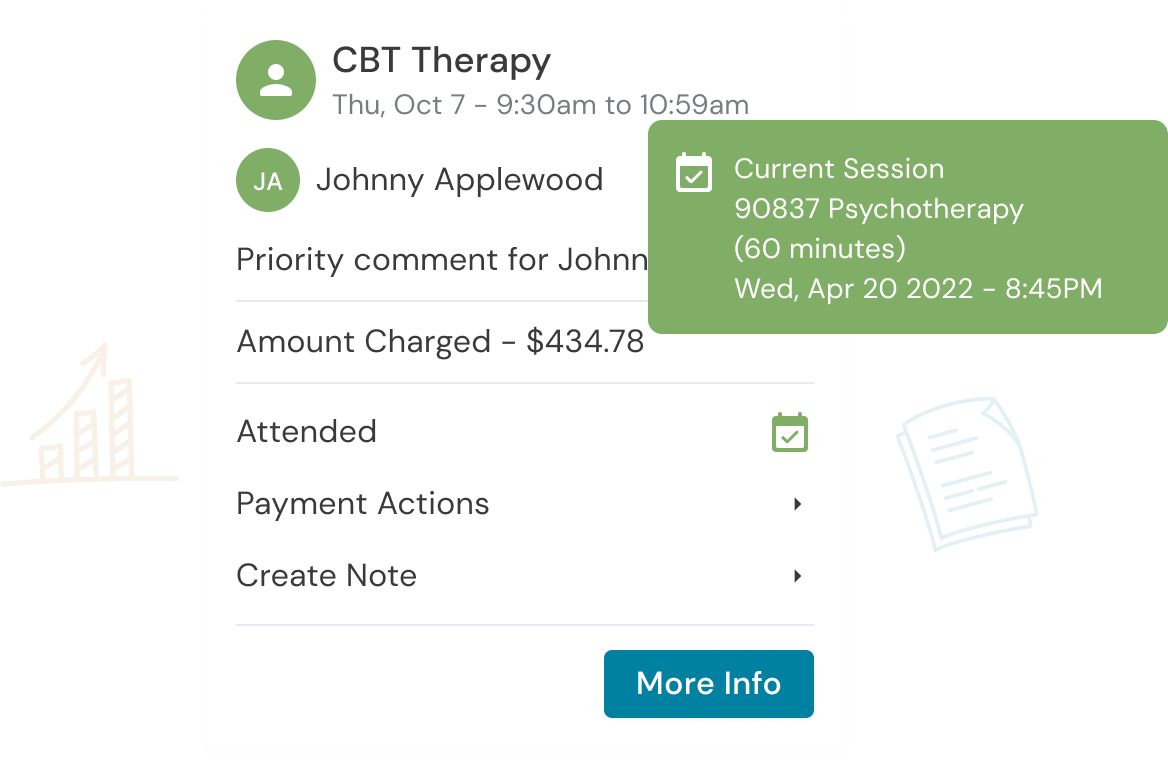Why Spring Is the Perfect Time to Hit Refresh
Spring has a way of nudging us toward fresh starts. Maybe you’re opening the windows, decluttering your office, or simply craving a little reset. It’s also the perfect time to turn that fresh-start energy toward your practice’s online presence.
Let’s be honest — when things get busy, your website, bios, and profiles can start to collect dust. They might not reflect the amazing work you’re doing now or speak to the clients you’re most excited to support. A thoughtful spring marketing refresh can boost your visibility, help the right people find you, and make your practice feel more aligned.
Here’s your friendly, therapist-focused checklist to breathe new life into your marketing materials.

Is Your Website in Good Shape? Let’s Check
Think of your website as the front door to your practice. If someone clicks through and finds outdated info, broken links, or fuzzy photos, they might just keep walking. Here’s how to spruce things up.
1. Run a Quick Tech Check
Start with the basics:
- Are there broken links or error messages?
- Do all your plugins and software updates look good?
- Is your site loading fast — especially on mobile?
And don’t forget this one: double check that your contact form or booking system is working. Have a friend or colleague give it a test run. It only takes a few minutes but can save you from missed opportunities.
2. Read Your Homepage Like a First-Time Visitor
Does your homepage clearly explain who you are and how you help? Are the calls to action — like “Book a Consultation” or “Learn More” — easy to find and intuitive?
Ask yourself:
- Do I mention my most up-to-date offerings?
- Are my fees, modalities, and availability current?
- Am I highlighting what makes my approach unique?
3. Update Core Pages and Content
Take a look at your About page, services, and FAQs. These pages should speak to who you’re working with now, not who you were serving a few years ago.
4. Freshen Up the Look
Visuals matter. Replace outdated headshots, swap out tired imagery, and make sure your fonts and colours still reflect your tone. Are you aiming for grounded and calm? Bold and warm? Your design choices should match the energy you bring to sessions.
5. How Does It Look on Mobile?
Over 60% of web traffic now comes from mobile phones. Pull up your site on your phone and scroll through like a client would. Are buttons cut off? Is the text easy to read? If it’s hard to use on a small screen or it’s slow to load, people will bounce quickly.
6. Is Your Site Accessible to Everyone?
Accessibility isn’t optional — it’s part of providing ethical care. Take some time to do an accessibility audit using the WCAG guidelines. Look for things like:
- Alt text on images
- Clear colour contrast
- Keyboard-friendly navigation
- Compatibility with screen readers
Takeaway:
Your website should feel like a calm, welcoming space that invites clients in. Keeping it updated shows you’re engaged, organized, and thoughtful — just like in the therapy room.
When Was the Last Time You Touched Your Directory Profiles?
Online directories are still one of the top ways clients find therapists. But let’s face it — they’re easy to forget about once you’ve set them up.
1. Do a Full Audit
Go through each profile you’ve created (yes, all of them). Check for:
- Typos or outdated info
- An old photo that no longer reflects your style
- Services or fees that have changed
2. Speak to Your Current Ideal Client
Your client base might’ve shifted since you first wrote that bio. Maybe you’re working more with new parents, or folks navigating burnout. Make sure your language connects with the people you most want to serve.
3. Keep the Branding Consistent
If your website has a warm, casual tone but your directory bios sound stiff and clinical, clients may feel confused. Use a consistent voice, photo, and tone across platforms so everything feels cohesive.
Takeaway:
Updating your profiles helps clients feel confident that you’re a present, engaged, and organized professional.
Do Your Bios Still Reflect Who You Are as a Therapist?
Therapists evolve. That first version of your bio might not reflect the depth, clarity, or voice you’ve developed since then.
1. Give It a Read with Fresh Eyes
Ask yourself:
- Does this still sound like me?
- Is the tone aligned with how I talk to clients?
- Am I using plain language that feels approachable?
If you’re still using phrases like “providing a safe space,” dig deeper. What does that look like in your practice? How do you actually help people?
2. Align Language Across All Platforms
Your website, social bios, and directories should all sound like the same person. Consistent messaging makes you feel grounded and trustworthy.
3. Reflect Changes in Focus or Specialty
If you’ve done more training in somatic work, added new modalities, or shifted away from certain populations, your bio should reflect that. Make sure it’s attracting the kinds of clients who energize you.
Takeaway:
A strong, authentic bio can make the difference between someone clicking “Book Now” and moving on. Keep it fresh and true to where you are today.
Is Your Visual Brand Sending the Right Message?
Branding isn’t just for big companies. Your colours, fonts, and photos shape how clients feel when they land on your site or see your materials.
1. Look at the Big Picture
Does your current visual identity match your therapeutic vibe? For example:
- Soft pastels may evoke calm and nurturing
- Bold colours might feel more energetic or affirming
And if your fonts are hard to read or your layout feels cluttered, it could create unnecessary friction for prospective clients.
2. Time for a New Headshot?
If it’s been a few years — or your look or style has changed — it’s worth investing in updated photos. A warm, professional image goes a long way toward building trust.
3. Bring It All Together
Whether someone finds you through your website, business card, or Instagram, everything should look like it belongs to the same practice. Think of it as visual alignment: consistent design helps reinforce your credibility.
Tip: A mini style guide (with your fonts, colours, and logo) can help keep everything looking polished. Canva is a free design tool with great templates to start you off! It doesn’t have to be incredibly detailed, but it can help you visually take a step back and evaluate your brand.
Takeaway:
Your visual brand is part of the first impression. Make sure it says what you want it to say about your practice and approach.
Have You Reconnected with Your “Why”?
This is the part most therapists skip — but it might be the most important.
1. Revisit What Drives You
Why do you do this work? What values are central to your practice right now? Take time to name them — maybe on paper, maybe in a voice note. If they’ve evolved, your messaging should too.
2. Notice What’s Lighting You Up (or Draining You)
What sessions leave you feeling fulfilled? What kinds of client work make you excited to show up? Make sure your marketing materials are inviting those clients in.
3. Let Go of What No Longer Fits
Sometimes it’s not about adding — it’s about releasing. That old tagline, niche, or service you don’t enjoy? You have permission to move on.
Takeaway:
When you’re connected to your “why,” everything else flows more easily. You’ll write more naturally, show up more confidently, and attract the people who need exactly what you offer.
Your Spring Marketing Refresh Checklist
Ready to take action? Use this checklist to guide your updates and track progress.
Your Spring Marketing Refresh Checklist
Ready to take action? Use this checklist to guide your updates and track progress.
| Task | Description |
|---|---|
| Website Updated | Mobile-friendly, accessible, current services and contact info |
| Booking System Tested | Ask a friend or colleague to run through it |
| Directory Profiles Refreshed | Accurate, consistent, and aligned with your niche |
| Bios Rewritten | Voice, tone, and focus reflect your present-day practice |
| Visual Branding Audited | Cohesive look and feel across all materials |
| Messaging Realigned | Values and focus clearly articulated |
Want to make it more manageable? Choose one section per week and work through it in small steps.
FAQs: Therapist Marketing Refresh Edition
What are some website maintenance tips for therapy practices?
Check for broken links, update content, optimize for mobile, ensure your forms and booking system work, and follow WCAG accessibility guidelines.
How often should therapists refresh their marketing?
Aim for a refresh every 6 to 12 months. Spring and fall are great times to review everything.
Why should directory profiles be updated?
They’re often how new clients find you. Keeping them current improves visibility and ensures you’re attracting the right audience.
What are some key marketing asset recommendations for therapists and mental health practices?
Prioritize a clear, client-friendly website, consistent branding, updated bios, and accessible online listings.
How do I develop a strong, consistent brand voice?
Start with your values and who you love to work with. Then use that tone and language across all platforms, from your site to your social media.

Are you a new practice? Start with Owl.
Reduce clinical administrative tasks and transform more lives with Owl Practice. Owl Practice provides all the tools you need to make your practice successful. Join the thousands of care professionals using Owl to run their practice every day.




